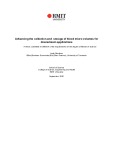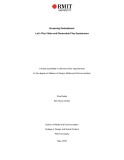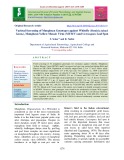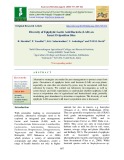
Field screening
-
The thesis is structured as follows: Chapter 1 reviews the literature and outlines the importance of blood, clinical use of blood, current methods of blood collection including alternative methods and the benefits of DBS. Chapter 2 summaries the overall methods used in the project. Chapter 3 explains the utility of hemaPEN® from both the collection and analytical perspective. Chapter 4 expands on the HCT bias associated with standard DBS method. Chapter 5 expands on the use of DBS in other fields such as genomic and epigenomics.
 164p
164p  runthenight04
runthenight04
 02-02-2023
02-02-2023
 7
7
 2
2
 Download
Download
-
Let’s Play videos are the practice whereby a videogame player records their experience to share with a future audience. They are an emergent form of cultural activity that has been relatively overlooked within the field of game studies. This thesis seeks to ask: how can access to videogame play moments (and performativity) provide insights into the understanding the dynamics of videogame play experience? This thesis approaches Let’s Play videos as a way in which to expand our understandings of videogame research.
 194p
194p  runthenight04
runthenight04
 02-02-2023
02-02-2023
 11
11
 3
3
 Download
Download
-
Field screening of 52 mungbean genotypes for resistance against whitefly, Mungbean Yellow Mosaic Virus (MYMV) and Cercospora leaf spot was carried out during Rabi and Kharif on 2015-2016. Population of whitefly ranged from 2.5 to 7.7 no./3 leaves while MYMV incidence ranged from 13.7 to 66.2 per cent. Two cultures viz., VBN 2 and CO 8 recorded low mean population of whitefly 2.5 and 2.7 no/3 leaves, respectively followed by VBN-3 (2.9 no. /3 leaves), PDM-54 (3.1 no. /3 leaves) and GM 4 (3.5 no. /3 leaves) whereas RM 612 recorded high mean population of whitefly (7.7 no.
 8p
8p  chauchaungayxua6
chauchaungayxua6
 26-06-2020
26-06-2020
 17
17
 3
3
 Download
Download
-
Alternative strategies are needed in pest management to protect crops from pests. Occurrence of epiphytic lactic acid bacteria (LAB) on crop plants, especially on sites that are selected by pests, may be associated with host selection by insects. We carried out laboratory investigations as well as screen house and field experiments to understand whether epiphytic LAB occur at oviposition sites of agricultural and horticultural crops, probably modulating pest abundance by attraction or repulsion. The diversity of such epiphytic LAB associated with insect oviposition sites is discussed.
 15p
15p  nguaconbaynhay5
nguaconbaynhay5
 16-05-2020
16-05-2020
 19
19
 3
3
 Download
Download
CHỦ ĐỀ BẠN MUỐN TÌM

















